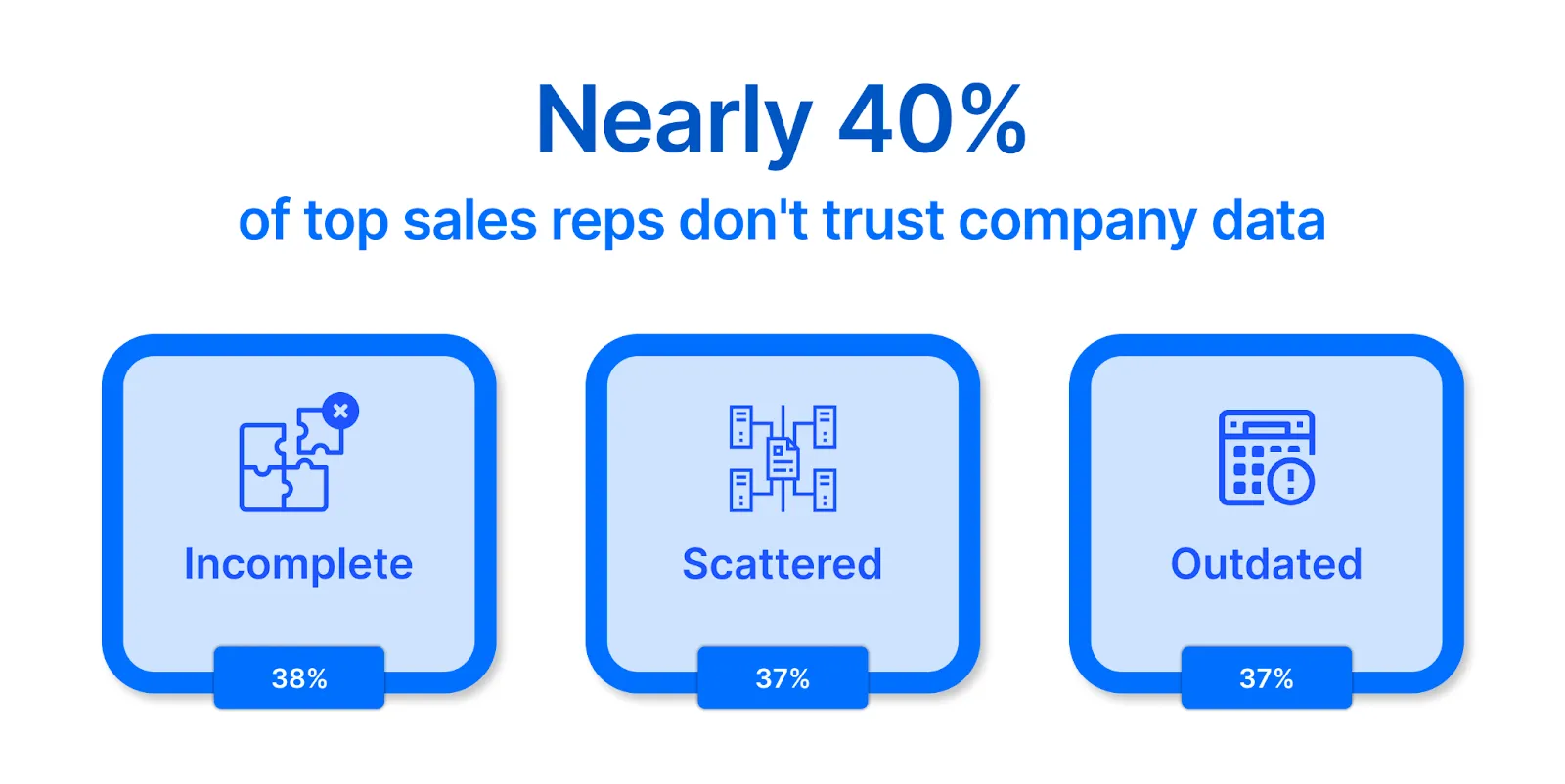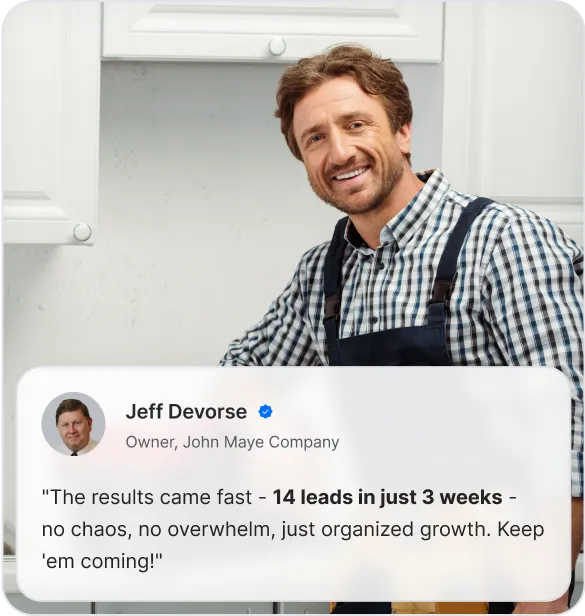Your product is better. Your prices are competitive. Your service is solid.
So why did you lose three major deals this quarter to companies you should beat every time?

The answer isn't in your factory. It's in how your sales team sells.
Think about your last big loss. You probably spent hours wondering what went wrong. Maybe you even called the prospect to ask for feedback.
"We went with someone else," or "It was a close decision," or the classic "We'll keep you in mind for next time."
But here's what really happened: Your competitor's sales rep made it easier for the buyer to say yes.
Not with a better product or a lower price. But with better sales support.
Your rep couldn't find the right technical specs during the meeting. Their rep had everything organized and ready. When the buyer wanted custom payment terms, your team had to check with three different people over several days. Their rep had pre-approved options and closed the deal that afternoon. After the meeting, your rep sent a generic follow-up. They sent a detailed proposal with exactly what the buyer needed to convince their boss.
So what's causing this difference?
It's not about hiring better people; you probably already have a solid team!
What your team needs is sales enablement—the difference between hoping your reps figure it out and making sure they have everything they need to win.
What Exactly is Sales Enablement for Manufacturers? And is it Really Important for Your Team?
Sales enablement is a simple, systematic process of giving your sales team the right plan, content, tech, and tools to close more deals faster and more confidently.

As a manufacturer (distributor), you help them set up a system that supports the entire sales team, so they’re not doing everything manually or guessing what works and what doesn't—or getting confused about where leads are coming from.
The Problem: Your Team is Fighting With One Hand Tied
Right now, your sales reps are winging it. Every call is different. Every proposal is built from scratch. Every follow-up is whatever they remember to send.
Meanwhile, your competitor's reps have a playbook, pre-built content, and tools that make every interaction consistent and professional.
This is the key difference that separates a struggling sales team from a winning one.
Here's where this difference took root:
Think about how your sales team operates right now. Your rep gets a lead, picks up the phone, and starts from square one. "Hi, this is John from ABC Manufacturing. I understand you're looking for industrial components..."
The prospect has no idea who you are, what you make, or why they should care. So your rep spends the next 20 minutes explaining your company, your capabilities, and your product line.
Now imagine this instead: The same prospect calls your rep, but this time they say, "Hi John, I've been reading about your XYZ series on your website, and I think it might solve our production bottleneck. I read your case study about the automotive supplier, and it sounds exactly like our situation. Can we schedule a time to discuss implementation?"
In the first scenario, your rep is a teacher. In the second, your rep is a consultant solving specific problems.
Traditional vs. Sales Process
So how do you make that shift? Get started with these top 5 tried and tested methods:
#1 Don’t Make Your Sales Team Start from Day Zero
Who builds this foundation? You do—but not the way you think. Most manufacturers assume this means "marketing stuff" or "digital whatever." It doesn't. This is about creating the materials your prospects need to make buying decisions: technical specs in PDF format, equipment videos on your website, and case studies showing real results.
When does your sales team actually start? When prospects raise their hand. Instead of cold-calling to introduce your company, your reps call people who've already downloaded your buyer's guide, requested a quote, or attended your webinar. The education phase is done—now they're ready to buy.
Your competitors aren't just selling products anymore, they're selling confidence. When their rep walks into a meeting, the buyer has already seen case studies, downloaded technical specs, and watched videos of their equipment in action.
You probably already have 80% of what you need sitting in filing cabinets, on hard drives, or in someone's head. The key is organizing it so prospects can find answers before they call.
But having content sitting around won't help if prospects can't access it when they need it.
#2 Build a Website That Works Like Your Best Sales Rep
Your website should qualify leads, answer common questions, and build trust before the phone rings—just like your most experienced rep does in person.
Right now, most manufacturing websites are digital brochures. They list what you make, maybe show some photos, and hope visitors will call. But prospects visit your website at 11 PM after a long day, trying to figure out if you can solve their problem. They can't find specific information, so they move on to your competitor, who made it easier to get answers.

Your website needs to:
- Clearly show what you sell and who your customers are
- Work smoothly on phones and tablets
- Include location-based keywords like "Industrial Valve Supplier in Texas"
- Make it easy to find contact info, product details, and submit contact us forms
When your website works properly, leads start calling with better questions. Instead of "What do you guys do?" you get "I saw your case study about reducing cycle times by 30%. Can we talk about how that would work in our facility?"
This foundation only works if you're creating the right materials to support both buyers and your sales team.
#3 Create Content That Answers Buyer Questions Before They Even Ask
Here's something that might surprise you: Your prospects are doing most of their research without you.

Before they ever call your sales team, they've already decided if you're worth talking to. They've compared your capabilities to your competitors. They’ve tried to figure out if you can handle their volume of orders. They even wonder if you're reliable enough to bet on their production schedule.
The question is: Are you part of that research process, or are you just hoping they'll give you a chance to explain everything on a sales call?
Most manufacturers leave this to chance.
They assume prospects will call when they're ready to buy. But here's what actually happens: Your customers research online, can't find the answers they need, and move on to someone who made it easier to get those answers.
The solution is creating content that works like having your best sales rep available 24/7.
You don't need to overcomplicate this. Focus on getting three things right: a clear website with quality information, an accurate business profile that shows up in searches, and a mobile-friendly design that works when prospects look you up after meeting you at trade shows.
Remember, the goal isn't to impress people with fancy technology. It's to make sure leads can easily find the information they need to say yes to working with you.
#4 Give Your Sales Team Tools That Actually Help Them Close
Here's where most sales enablement efforts go wrong: Companies create difficult systems that their sales teams never actually use.
Your reps are already busy. They're managing existing accounts, chasing down quotes, and putting out fires. The last thing they need is another complicated process that slows them down. What they need are tools that make their current work easier and more effective.
Sales enablement isn't about starting from scratch or replacing what's already working in your business. It's about making your current sales efforts stronger by adding the right support where it matters most.
- You put a lot of effort into trade shows, so don’t let that effort go to waste.
You're already spending $$$ on trade shows—booth space, travel, product displays, and your team's time. But most manufacturers watch those leads go cold because there's no system to keep the conversation going after the event.
Instead, use your website as a hub that trade show visitors can access instantly.
Put a QR code on your booth banners that visitors can scan to get detailed product info, pricing, or submit RFQs on the spot.
This makes it easy for prospects to connect with you online even after the event ends, when they're back at their office trying to remember which suppliers they talked to.
- Give your sales reps the tools and content they need.
Your sales team shouldn't have to hunt down product specs, dig through old email chains for pricing, or wonder if the information they're sharing is current.
When a hot prospect calls, your reps need to move fast, not spend 20 minutes trying to find the right brochure.
This means providing updated brochures, ready-to-send email templates, and direct links to your products so they can quickly share accurate information without playing phone tag.
When your sales team has reliable, current information at their fingertips, their confidence shows. And confident reps close more deals.
- Cold calls aren’t about introducing yourself anymore.
If your customer knows you already, it’s a big win.
Instead of spending the first 10 minutes explaining who you are and what you do, your reps can jump straight into understanding the prospect's specific needs and how you can help.
When you follow up on something prospects already showed interest in, like a product spec they downloaded or pricing they requested, you can move deals forward faster.
You're not interrupting their day with an unwanted sales pitch; you're providing information they're actively looking for.
#5 Don’t Go Big, Just Start Right (With the Right Help)
Don't try to implement everything at once. Focus on building a strong foundation first:
Week 1-2:
- Simple website showing what you do with clear contact methods
- Google Business Profile updated with accurate information
Week 3-4:
- 2-3 pieces of content answering your most common buyer questions
- One-page product sheets your sales team can actually use
Week 5-6:
- Basic lead tracking (even a simple spreadsheet works)
- Connect your trade show efforts to your website with QR codes
Keep it practical:
- Use WhatsApp buttons or inquiry forms for quick contact
- Show real pictures of your facility and products to build trust
- Collect 2-3 client testimonials for your homepage
- Track where your leads come from so you know what's working
Remember, sales enablement works best when sales and marketing support each other. Marketing creates helpful content that educates your prospects. When they finally call your sales team, they already know what you do, trust that you understand their problem, and are ready to talk specifics. Your sales rep doesn't start from zero—the customer is already halfway convinced.
Quick Wins That Actually Work
Here are practical tips you can implement immediately:

Keep it simple and visual: Skip technical jargon for clear, easy-to-understand language. Use pictures that help customers quickly grasp what you offer, saving time and reducing confusion.
Show real facility photos: Pictures of your factory, machinery, or finished products build trust. Real images make your business feel authentic and transparent—something buyers value when choosing suppliers.

Feature 2-3 client testimonials on your homepage: Word-of-mouth still matters in manufacturing. Testimonials act like personal recommendations that reassure potential buyers and show others trust you.
Make contact effortless: Add WhatsApp buttons or simple inquiry forms so buyers can ask questions instantly without hunting for your phone number or writing formal emails.
Track your lead sources: Monitor whether leads come from your website, trade shows, Google ads, or referrals. This shows you what's actually driving business so you can focus your efforts.
Before You Go, Here's What Matters Most
Five strategies, multiple tools, content creation—it's easy to feel overwhelmed. You don't need to do everything at once. In fact, trying to implement all five ideas simultaneously is the fastest way to get nothing done.
Start with this foundation:
- Stop letting your sales team start from zero every time
- Build a website that works like your best sales rep
- Create content that answers buyer questions before they ask
- Give your sales team tools that actually help them close
- Make it easy for prospects to stay engaged throughout the process
The difference between manufacturers who win and those who wonder why they lost isn't in the factory. It's “who made it easier for buyers to say yes”.
Start with one improvement, get it working, then add the next. Your sales team and your bottom line will thank you.
Stop Losing Deals: Build a Sales System That Works Without You
At Gushwork, we help manufacturers build lead generation systems that work 24/7, year-round.
Yes, we create content that helps your buyers understand your products, get you found on Google when they search, and run targeted ads that bring in ready-to-buy prospects.
Your sales team gets warm leads who already know what you do and want to buy. No more cold reaches. No more starting from zero. Just qualified prospects ready to close.
When your next rep quits, your leads still keep flowing through your website content.
Many other manufacturers have already started using website content to generate more effective leads. Click here to talk to an expert!
FAQs
1. What are the three pillars of sales enablement?
The three pillars are Planning (organizing your sales process and lead prioritization), Content (creating materials that help both buyers and sales reps), and Technology (using simple tools to track leads and automate follow-ups). These work together to support your sales team at every step of the process.
2. How to measure the success of sales enablement?
Track three major metrics: faster sales cycles (deals closing quicker), higher conversion rates (more leads becoming customers), and consistent performance across your sales team (not just relying on star performers). If these improve, your sales enablement is working.
3. What is the sales enablement framework?
A sales enablement framework is your step-by-step plan for supporting sales reps. It includes: identifying what buyers need at each stage, creating content to address those needs, training your team to use the materials, and tracking what works to improve results continuously.
4. What is the primary goal of sales enablement?
The primary goal is to help your sales team close more deals faster by giving them the right tools, content, and processes. Instead of reps guessing what works, they have proven systems that consistently turn prospects into customers.
5. What is the difference between sales operations and sales enablement?
Sales operations manages the technical side—Customer relationship management (CRM) systems, reporting, and data analysis. Sales enablement focuses on helping reps sell better through content, training, and buyer-focused materials. Operations handles the "how" of tracking sales; enablement handles the "what" of selling effectively.



















.webp)








.webp)

.svg)


.svg)
.svg)
.svg)




.svg)




.svg)